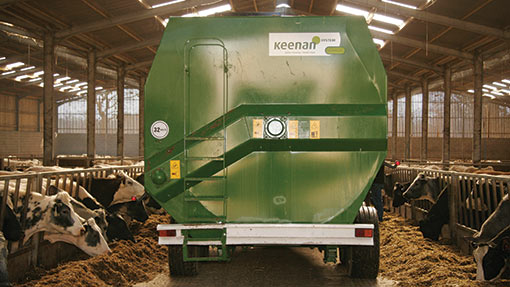Ration consistency is key to getting more milk this winter

Dairy farmers can reduce the variation of TMR by more than 10% simply by adjusting the loading procedure and mixing times.
Francisco Ysunza, technical manager from nutrition company Diamond V, advised farmers to follow several simple steps to ensure cows were receiving the same ration across the feed passage.
“Ration consistency can have a big influence on milk yield,” explained Dr Ysunza at a Countrywide seminar at Poyerston Farm, Cosheston, Pembrokeshire.
He said it was therefore vital for farmers to ensure cows were eating the same meal every day, as well as the same as the rest of the pen.
The day before the seminar, Dr Ysunza took 10 samples of TMR from the feed passage as it was delivered to cows at Coomb Farm, Llangynog, Carmarthenshire.
Presenting the findings, he said particle size analysis showed the ration varied by as much as 18% – the equivalent of four litres of milk a cow.
But, by adjusting the order in which the ingredients were added to the mixer wagon and altering mixing times, Dr Ysunza reduced ration variation to just 5%.
“We added the dry fibre first, then liquids and increased mixing time [after the last load] from two-and-a-half minutes to four minutes. This improved variation threefold,” explained Dr Ysunza.
Previously fibre had been added last and molasses and concentrates first and second.
Improving consistency
“First have a protocol set up and know the quantity of your ingredients, the process you follow to load and mix and how you deliver that feed,” he advised.
“Separating particle sizes gives you a way of assessing how consistent or inconsistent that ration is along the feed trough.”
But he warned that when assessing results it was the variation – from smallest to largest – that was important, rather than the average.
Mixing guidelines
“There are guidelines to follow. For any mix I personally recommend adding the dry ingredients before the wet ones and I tend to add the more finely ground ingredients and low inclusion ones such as additives towards the middle.”
However, he said it did depend on the type of mixer wagon being used. If farmers were using a horizontal mixer he suggested adding liquids to the mix last, but for those using a vertical one, he advised adding liquids second or third.
Mixing times
Dr Ysunza said often farmers who have problems with ration variation mix the ration for longer periods of time. But he warned this doesn’t help.
Instead he explained it was the speed at which the ration is mixed that was most important.
If farmers are using a vertical mixer, Dr Ysunza recommended a mixing of at least 30rpm.
See also: ‘Feed cows little and often to cut ration sorting’
